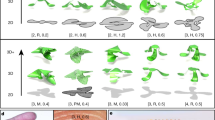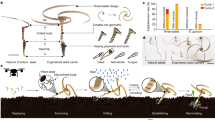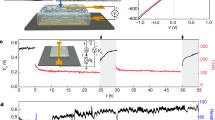Abstract
Plants cover a large fraction of the Earth’s land mass despite most species having limited to no mobility. To transport their propagules, many plants have evolved mechanisms to disperse their seeds using the wind1,2,3,4. A dandelion seed, for example, has a bristly filament structure that decreases its terminal velocity and helps orient the seed as it wafts to the ground5. Inspired by this, we demonstrate wind dispersal of battery-free wireless sensing devices. Our millimetre-scale devices weigh 30 milligrams and are designed on a flexible substrate using programmable, off-the-shelf parts to enable scalability and flexibility for various sensing and computing applications. The system is powered using lightweight solar cells and an energy harvesting circuit that is robust to low and variable light conditions, and has a backscatter communication link that enables data transmission. To achieve the wide-area dispersal and upright landing that is necessary for solar power harvesting, we developed dandelion-inspired, thin-film porous structures that achieve a terminal velocity of 0.87 ± 0.02 metres per second and aerodynamic stability with a probability of upright landing of over 95%. Our results in outdoor environments demonstrate that these devices can travel 50–100 metres in gentle to moderate breeze. Finally, in natural systems, variance in individual seed morphology causes some seeds to fall closer and others to travel farther. We adopt a similar approach and show how we can modulate the porosity and diameter of the structures to achieve dispersal variation across devices.
This is a preview of subscription content, access via your institution
Access options
Access Nature and 54 other Nature Portfolio journals
Get Nature+, our best-value online-access subscription
$29.99 / 30 days
cancel any time
Subscribe to this journal
Receive 51 print issues and online access
$199.00 per year
only $3.90 per issue
Buy this article
- Purchase on Springer Link
- Instant access to full article PDF
Prices may be subject to local taxes which are calculated during checkout




Similar content being viewed by others
Data availability
All data needed to evaluate the conclusions of the paper are available in the paper or in the Extended Data and Supplementary Information.
Code availability
Source code is available on a public GitHub repository for download: https://github.com/uw-x/wind_dispersal/.
References
Cummins, C. et al. A separated vortex ring underlies the flight of the dandelion. Nature 562, 414–418 (2018).
Lentink, D., Dickson, W. B., van Leeuwen, J. L. & Dickinson, M. H. Leading-edge vortices elevate lift of autorotating plant seeds. Science 324, 1438–1440 (2009).
Greene, D. F. The role of abscission in long-distance seed dispersal by the wind. Ecology 86, 3105–3110 (2005).
Greene, D. F. & Johnson, E. A. The aerodynamics of plumed seeds. Funct. Ecol. 4, 117–125 (1990).
Sheldon, J. C. & Burrows, F. M. The dispersal effectiveness of the achene–pappus units of selected Compositae in steady winds with convection. New Phytol. 72, 665–675 (1973).
Andersen, M. C. Diaspore morphology and seed dispersal in several wind-dispersed Asteraceae. Am. J. Bot. 80, 487–492 (1993).
Casseau, V., De Croon, G., Izzo, D. & Pandolfi, C. Morphologic and aerodynamic considerations regarding the plumed seeds of Tragopogon pratensis and their implications for seed dispersal. PLoS ONE 10, e0125040 (2015).
Augspurger, C. K. & Franson, S. E. Wind dispersal of artificial fruits varying in mass, area, and morphology. Ecology 68, 27–42 (1987).
Andersen, M. C. An analysis of variability in seed settling velocities of several wind-dispersed Asteraceae. Am. J. Bot. 79, 1087–1091 (1992).
Edwards, D. J. et al. CICADA flying circuit board unmanned aerial vehicle. In 2018 AIAA Aerospace Sciences Meeting 1008 (AIAA, 2018).
Pounds, P. & Singh, S. Samara: biologically inspired self-deploying sensor networks. IEEE Potentials 34, 10–14 (2015).
Iyer, V., Kim, M., Xue, S., Wang, A. & Gollakota, S. Airdropping sensor networks from drones and insects. In MobiCom ’20: Proc. 26th Annu. Intl Conf. Mobile Computing and Networking 61 (ACM, 2020).
Vogel, S. Life in Moving Fluids: The Physical Biology of Flow 2nd edn (Princeton Univ. Press, 2020).
Seo, D. et al. Wireless recording in the peripheral nervous system with ultrasonic neural dust. Neuron 91, 529–539 (2016).
Kahn, J. M., Katz, R. H. & Pister, K. S. J. Next century challenges: mobile networking for “Smart Dust”. In MobiCom ’99: Proc. 5th Annu. Intl Conf. Mobile Computing and Networking (eds Kodesh, H. et al.) 271–278 (ACM, 1999).
Lee, Y. et al. A modular 1 mm3 die-stacked sensing platform with low power I2C inter-die communication and multi-modal energy harvesting. IEEE J. Solid-State Circ. 48, 229–243 (2013).
Chen, Y. et al. Energy-autonomous wireless communication for millimeter scale Internet-of-Things sensor nodes. IEEE J. Sel. Area Commun. 34, 3962–3977 (2016).
Chuo, L.-X. et al. A 915 MHz asymmetric radio using Q-enhanced amplifier for a fully integrated 3 × 3 × 3 mm3 wireless sensor node with 20 m non-line-of-sight communication. In IEEE Intl Solid-State Circuits Conf. 132–133 (IEEE, 2017).
Iyer, V., Najafi, A., James, J., Fuller, S. & Gollakota, S. Wireless steerable vision for live insects and insect-scale robots. Sci. Robotics 5, abb0839 (2020).
Rostami, M., Sundaresan, K., Chai, E., Rangarajan, S. & Ganesan, D. Redefining passive in backscattering with commodity devices. MobiCom ’20: Proc. 26th Annu. Intl Conf. Mobile Computing and Networking 3 (ACM, 2020).
Iyer, V., Nandakumar, R., Wang, A., Fuller, S. B. & Gollakota, S. Living IoT: a flying wireless platform on live insects. In MobiCom ’19: 25th Annu. Intl Conf. Mobile Computing and Networking (eds Agarwal, S. et al.) 5 (ACM, 2019).
Talla, V. et al. LoRa backscatter: enabling the vision of ubiquitous connectivity. In Proc. ACM Interactive, Mobile, Wearable and Ubiquitous Technologies 105 (ACM, 2017).
Kim, B. H. et al. Three-dimensional electronic microfliers inspired by wind-dispersed seeds. Nature 597, 503–510 (2021).
Zussman, E., Yarin, A. & Weihs, D. A micro-aerodynamic decelerator based on permeable surfaces of nanofiber mats. Exp. Fluids 33, 315–320 (2002).
Lentink, D., Dickson, W. B., van Leeuwen, J. L. & Dickinson, M. H. Leading-edge vortices elevate lift of autorotating plant seeds. Science 324, 1438–1440 (2009).
James, J., Iyer, V., Chukewad, Y., Gollakota, S. & Fuller, S. B. Liftoff of a 190 mg laser-powered aerial vehicle: the lightest wireless robot to fly. In 2018 IEEE Intl Conf. Robotics and Automation (ICRA) (ed. Lynch, K.) 3587–3594 (IEEE, 2018).
Katanbaf, M., Weinand, A. & Talla, V. Simplifying backscatter deployment: full-duplex LoRa backscatter. In 18th Symp. Networked Systems Design and Implementation 955–972 (USENIX, 2021).
Shen, S. et al. An LC passive wireless gas sensor based on PANI/CNT composite. Sensors 18, 3022 (2018).
Nandakumar, R., Iyer, V. & Gollakota, S. 3D Localization for Sub-Centimeter Sized Devices. In SenSys '18: Proceedings of the 16th ACM Conference on Embedded Networked Sensor Systems (eds Zhang, L. et al.) 108–119 (ACM 2018).
Riley, J. R. et al. Tracking bees with harmonic radar. Nature 379, 29–30 (1996).
Acknowledgements
We thank S. Kaplan and J. Smith for feedback on the manuscript and K. Johnson, V. Arroyos and B. Nguyen for help with experiments. This research is funded by Moore Inventor Fellow award #10617 and grant FA9550-14-1-0398 from the US Air Force Office of Scientific Research. S.G. is also funded by the National Science Foundation.
Author information
Authors and Affiliations
Contributions
V.I. designed and fabricated the hardware and performed experiments. S.G. and V.I. designed the overall system, experiments and evaluation. T.D. advised on the design and characterization of the drag-enhancing structures. H.G. implemented the backscatter code and sensor release mechanism used for outdoor testing. V.I. and S.G. wrote the manuscript; T.D. edited the manuscript. S.G. and V.I conceptualized the work.
Corresponding authors
Ethics declarations
Competing interests
S.G. is a co-founder of Jeeva Wireless, Wavely Diagnostics, and Sound Life Sciences.
Peer review
Peer review information
Nature thanks Elizabeth Farrell Helbing and the other, anonymous, reviewer(s) for their contribution to the peer review of this work.
Additional information
Publisher’s note Springer Nature remains neutral with regard to jurisdictional claims in published maps and institutional affiliations.
Extended data figures and tables
Extended Data Fig. 1 Effect of outer ring on terminal velocity.
a, Terminal velocities of 26% fill structures with different diameters using a 30-mg payload. b, Terminal velocities of 55% fill structures with different diameters with and without an outer ring using a 30-mg payload.
Extended Data Fig. 2 Additional fill patterns.
Additional fill patterns used to vary porosity. Changes include concentric circles connecting horizontal spokes extending out from the centre with various spacings, as well as additional cuts in the concentric circles between spokes.
Extended Data Fig. 3 Fabrication process.
Fabrication process used to produce the curved drag enhancing structures.
Extended Data Fig. 4 SX1276 receiver on–off keying packet structure.
a, Packet structure for the SX1276 receiver operating in on–off keying mode. b, Minimal packet structure used for testing the lower bit rates of 1.5 and 4.8 kbps. CRC, cyclic redundancy check.
Extended Data Fig. 5 Supporting transmissions from multiple devices.
a, Natural variance of start-up time for outdoor measurements. b, Two waveforms recorded under similar light conditions show that natural variation in start-up time and time between packets reduces the probability of collisions. c, Addition of a random delay between each packet to reduce collisions. d, Network simulation of up to 1,000 nodes each transmit 100 packets. Node start and inter-packet transmission times are normally distributed based on power-harvesting data (N = 100 packets per node × 10 repetitions = 1,000). e, Network simulation with normally distributed start-up time assuming 1.4 klx followed by fixed 10-s delay between packets (N = 1000). f, Result of applying pseudorandom delays of up to 8 packet lengths with random start times assuming 1.4 klx (N = 1,000). The plot shows that this approach can support large networks where the data are transmitted at rates less than once every 10 s.
Extended Data Fig. 6 Additional power harvesting results.
a, Cold-start time required to charge the storage capacitor from zero to the time at which it can backscatter its first packet; measured using indoor LED lights (N ≥ 5, error bars = ±σ). b, Throughput of the sensor device after start up at different illumination levels indoors (N ≥ 5, error bars = ±σ). c, Measurements of power harvested at different light levels outdoors from our solar cells. (N ≥ 3, error bars = ±σ).
Extended Data Fig. 7 Drone mechanism to drop the sensors.
a, Small quadrotor with the mechanism used to drop devices from altitudes over 5 m outdoors. b, Drop mechanism consisting of a solenoid that can be wirelessly triggered by a Bluetooth transmission. Upon triggering, the supercapacitor keeps the solenoid retracted for a few seconds allowing the wire holding the sensor in place to fall freely. Because our evaluation requires tracking each individual structure, the drone attachment currently drops a single device. It can be extended to drop multiple devices simultaneously using a similar mechanism.
Extended Data Fig. 8 Sensor calibration set-up using a weather station.
a, Picture of weather station used for reference temperature, humidity, solar radiation and pressure measurements, and placement of the test wireless sensor node. b, Correlation of small onboard light sensor readings with reference solar radiation data. c, Correlation of small, onboard temperature sensor (HDC2010) readings with reference solar radiation data. d, Correlation of onboard temperature sensor temperature sensor (BME280) readings with reference solar radiation data.
Extended Data Fig. 9 Prototype full-duplex cancellation of our narrowband signals.
a, Full-duplex cancellation block diagram. b, Results of applying full-duplex cancellation to reduce transmitter interference for backscatter.
Supplementary information
Supplementary Information
This file contains three Supplementary Tables and their accompanying legends; and the legends for Supplementary Videos 1–6.
Supplementary Video 1
Vertical wind tunnel test.
Supplementary Video 2
Effect of outer ring.
Supplementary Video 3
Effect of stiffness.
Supplementary Video 4
Unstable descent of solid discs.
Supplementary Video 5
Self-righting behaviour.
Supplementary Video 6
Outdoor wind dispersal.
Rights and permissions
About this article
Cite this article
Iyer, V., Gaensbauer, H., Daniel, T.L. et al. Wind dispersal of battery-free wireless devices. Nature 603, 427–433 (2022). https://doi.org/10.1038/s41586-021-04363-9
Received:
Accepted:
Published:
Issue Date:
DOI: https://doi.org/10.1038/s41586-021-04363-9
This article is cited by
-
Bioinspired rotary flight of light-driven composite films
Nature Communications (2023)
-
Light-driven dandelion-inspired microfliers
Nature Communications (2023)
-
Shape morphing of plastic films
Nature Communications (2022)
Comments
By submitting a comment you agree to abide by our Terms and Community Guidelines. If you find something abusive or that does not comply with our terms or guidelines please flag it as inappropriate.



